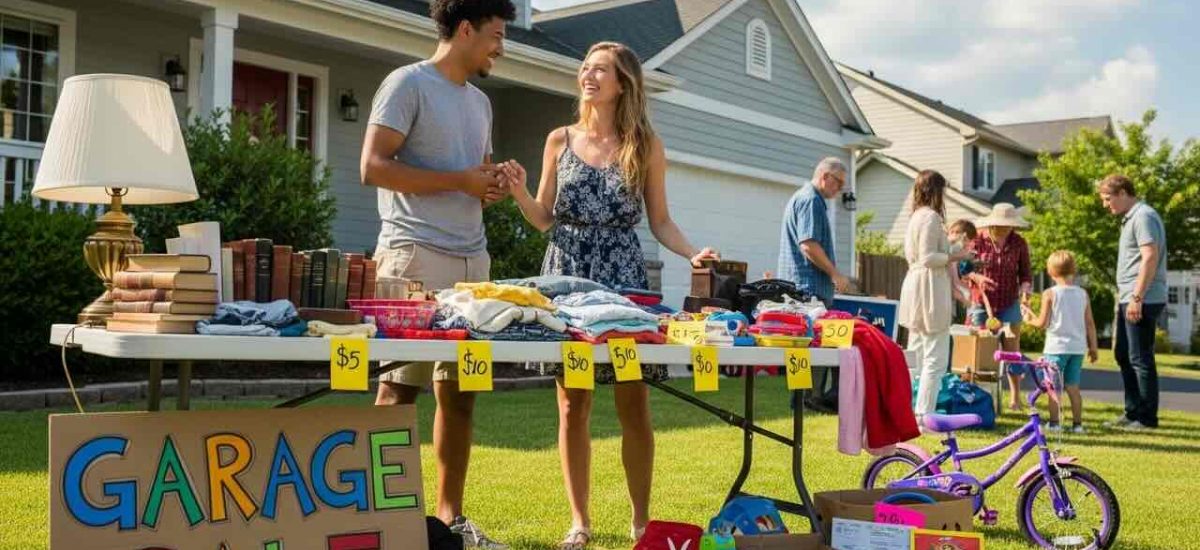Downsize when moving means deciding which belongings make the journey with you and which ones don’t. Whether you’re moving from a house to an apartment, becoming an empty nester, relocating for work, or simply choosing to live with less, the process requires making hundreds of small decisions about objects that may carry years of history and habit.
The challenge isn’t just physical logistics. It’s the emotional weight of letting go, the uncertainty about what you’ll actually need, and the friction of deciding what’s worth keeping versus what’s taking up space. This guide walks through practical ways for making those decisions, timelines that prevent last-minute panic, and ways to handle the inevitable attachment that comes with items you’ve owned for decades.
Key Points
- Starting 8 to 12 weeks before your move gives you time to make thoughtful decisions without the pressure of looming deadlines; last-minute downsizing often leads to regret or keeping too much.
- A useful decision rule is “Have I used this in the past year, and will I use it in the next six months?” If the answer to both is no and the item isn’t seasonal or sentimental, it’s usually safe to let it go.
- Furniture that won’t physically fit in your new space (measured carefully, including doorways and staircases) should be sold or donated before the move; paying to transport items you can’t use wastes money and creates immediate clutter.
- Selling items takes more time than most people expect; plan 4 to 6 weeks for online listings, estate sales, or consignment, and be realistic about what actually has resale value versus what’s better donated.
- Storage units cost $80 to $300 per month and add up quickly; if you’re storing items “just in case,” calculate the annual cost and ask whether buying replacements later would be cheaper than years of storage fees.
Why Downsize When Moving: Benefits Beyond Just Fitting Into a Smaller Space
The most obvious reason to downsize is spatial: your new home is smaller, and not everything will fit. But downsizing offers other advantages that become clear once you’re settled.
Lower Moving Costs
Moving companies price by volume and weight. Reducing your belongings by 30 to 40 percent can drop your moving estimate by $500 to $2,000 or more, depending on distance and household size. Fewer boxes mean a smaller truck, fewer crew hours, and less packing material. If you’re moving long-distance, weight-based pricing makes downsizing especially cost-effective.
Less Maintenance and Cleaning
Fewer possessions mean less to dust, organize, repair, and manage. This shift becomes more noticeable in smaller spaces where every item is visible and clutter accumulates faster. Many people find that living with less creates mental clarity and reduces the low-level stress of managing too much stuff.
Easier Future Moves
If this isn’t your last move, downsizing now makes future relocations simpler. You won’t accumulate as much between moves, and you’ll have practiced the decision-making process, which makes the next round easier.
Financial Reset
Selling unused items can generate $1,000 to $5,000 or more, depending on what you own. Furniture, electronics, tools, collectibles, and sporting equipment often have resale value if you’re willing to put in the effort. Even items you donate create tax deductions if you itemize and get receipts.
When to Start Downsizing: Timelines by Household Size
The bigger your home and the longer you’ve lived there, the more time you need. Here are general timelines that prevent last-minute overwhelm:
| Current Home Size | Recommended Start Time | Why This Timeline |
|---|---|---|
| Studio or 1-bedroom apartment | 4 to 6 weeks before move | Smaller volume; fewer rooms to sort; can handle in weekends. |
| 2-bedroom apartment or small house | 6 to 8 weeks before move | More possessions; likely includes storage areas like closets, basement, garage. |
| 3-bedroom house | 8 to 12 weeks before move | Significant accumulated items; attic, basement, and garage add complexity. |
| 4+ bedroom house or long-term residence (10+ years) | 12 to 16 weeks before move | Decades of accumulation; may include inherited items, collections, or family heirlooms requiring careful decisions. |
If you’re downsizing as part of retirement, estate planning, or helping aging parents, add extra time for family discussions and coordination. Emotional processing takes longer than physical sorting, and rushing those conversations creates friction.
Decisions: How to Choose What Stays and What Goes
The hardest part of downsizing/decluttering isn’t the physical labor. It’s making hundreds of micro-decisions about objects that may carry memories, guilt, or uncertainty. Having a clear framework helps you move through decisions faster and with less regret.
The One-Year Rule
Ask yourself: “Have I used this item in the past year?” If no, follow up with: “Will I definitely use it in the next six months?” If both answers are no and the item isn’t seasonal (holiday decorations, winter gear) or sentimental, it’s usually safe to let it go. This rule works well for clothing, kitchen gadgets, books, and hobby supplies.
The Replacement Test
For items you’re unsure about, ask: “If I got rid of this and needed it later, how hard and expensive would it be to replace?” If the answer is “easy and under $50,” the risk of letting it go is low. If the item is rare, expensive, or irreplaceable, that’s a reason to keep it. This test helps with tools, electronics, and specialty equipment.
The Space Value Equation

In a smaller home, every item competes for limited space. Ask: “Is this worth the square footage it takes up?” A bulky exercise machine you rarely use might occupy 15 square feet. This is one of the most common moving mistakes that everyone does. Is that worth more than the open space, or could a gym membership or smaller equipment serve you better? This question is especially useful for furniture, sports gear, and large collections.
The Joy and Function Balance
Items that bring genuine joy or serve a clear function earn their place. Items that do neither are clutter. If something makes you happy to see or use regularly, keep it even if it’s not “practical.” If it’s purely functional but you never use it, let it go even if it seems like something you “should” have. This balance helps with decor, sentimental items, and gifts you feel obligated to keep.
Room-by-Room Downsize When Moving Strategy
Tackling one room at a time prevents overwhelm and gives you a sense of progress. Here’s how to approach each space:
Kitchen
Kitchens accumulate duplicate tools, single-use gadgets, and mismatched dishware. Start by pulling everything out of cabinets and drawers. Keep one set of dishes, glasses, and utensils per person in your household, plus a few extras for guests. Let go of appliances you haven’t used in a year (bread makers, juicers, fondue sets). Donate duplicates (three spatulas, four wooden spoons) and specialty items you can’t remember the last time you used.
If you’re moving to a smaller kitchen, measure your new cabinet and counter space before deciding what to keep. That stand mixer might not fit, and storing it in a closet defeats the purpose.
Bedroom and Closets
Clothing is one of the easiest categories to downsize because most people wear 20 to 30 percent of their wardrobe regularly. Use the hanger trick: turn all hangers backward, and after you wear an item, hang it normally. After three months, donate anything still facing backward.
For folded clothes, pull everything out and sort into three piles: wear regularly, wear occasionally, haven’t worn in a year. Keep the first pile, evaluate the second (is it seasonal? does it still fit? do you actually like it?), and donate or sell the third unless it’s formal wear or special-occasion clothing you’ll need soon.
Shoes, bags, and accessories follow the same rule. If you haven’t used it in a year and it’s not seasonal, it’s taking up space you’ll need in a smaller closet.
Living Room and Den
Furniture is the big decision here. Measure your new living space carefully, including doorways, hallways, and staircases. If your sectional sofa is 10 feet long and your new living room is 12 feet wide, it won’t work. Sell or donate furniture that doesn’t fit before the move.
Books, DVDs, CDs, and media collections are heavy and take up significant space. Keep favorites and items you reference regularly; donate or sell the rest. Many people digitize media collections or shift to streaming and library borrowing after downsizing.
Garage, Basement, and Attic
These spaces hold the hardest decisions because they’re where things go to be forgotten. Tools, holiday decorations, sports equipment, camping gear, and boxes of “someday” projects accumulate here. Start by sorting everything into categories: keep, sell, donate, trash.
Be ruthless with broken items you’ve been meaning to fix, hobby supplies for hobbies you no longer pursue, and things you’re keeping “just in case.” If you haven’t needed it in three years, you probably won’t. For seasonal items like holiday decorations, keep what you actually use each year and let go of duplicates or things that no longer fit your style.
Home Office and Paperwork
Paperwork often triggers anxiety because people worry about tossing something important. General guidelines: keep tax returns and supporting documents for seven years, keep proof of major purchases and home improvements, and digitize everything else. Shred old bank statements, expired insurance policies, and utility bills older than a year.
Office supplies rarely need to move in bulk. Keep one set of basics (pens, stapler, tape, scissors) and donate the excess. Old electronics, cables, and chargers for devices you no longer own can go to e-waste recycling.
Handling Sentimental Items and Family Heirlooms
Sentimental items are the most emotionally difficult to downsize because they represent memories, relationships, and identity. You can’t approach them with the same logic as kitchen gadgets.
Photographs and Memorabilia
Instead of keeping every photo album and box of memorabilia, curate the collection. Choose the best 20 to 30 percent of photos that tell the story or bring you joy, and let go of duplicates, blurry shots, or photos of people you don’t remember. Digitize what you’re keeping so you have a backup and can share easily with family.
For children’s artwork, school projects, and report cards, create a memory box for each child with a selection of highlights rather than saving everything. One small bin per child is manageable; ten bins per child is overwhelming.
Inherited Items and Family Heirlooms
Guilt around inherited items is common. You may feel obligated to keep your grandmother’s china or your father’s tools even if you don’t use them. Remember that the memory isn’t in the object. If keeping something causes stress (it doesn’t fit your style, you have no space, you never use it), it’s okay to pass it to another family member who wants it or to let it go.
Consider taking photos of sentimental items before donating them. The photo preserves the memory without the physical storage burden. You can also repurpose heirlooms: turn a quilt into throw pillows, frame a piece of jewelry, or use vintage dishes as decor rather than storing full sets you never use.
Gifts and Obligation Items
Gifts you feel obligated to keep but don’t actually like create resentment and clutter. The giver gave you a gift to make you happy, not to burden you. If it doesn’t serve you, it’s okay to let it go. Donate it, sell it, or pass it along to someone who will use it. The thought was appreciated; the object doesn’t have to stay forever.
What to Sell, Donate, or Trash
Once you’ve decided what’s leaving, the next question is where it goes. Here’s how to sort items into these categories efficiently:
What to Sell
Selling takes time and effort, so focus on items worth $50 or more. Good candidates include:
- Furniture in good condition (sofas, dining tables, dressers, bed frames)
- Electronics (TVs, laptops, tablets, gaming consoles, speakers)
- Appliances (washer, dryer, refrigerator if not built-in)
- Tools and equipment (power tools, lawn mowers, bikes, exercise machines)
- Collectibles, antiques, or vintage items with known value
- Designer clothing, handbags, or accessories in good shape
Selling platforms include Facebook Marketplace, Craigslist, OfferUp, eBay (for smaller items), Poshmark or ThredUp (for clothing), and local consignment shops. Estate sale companies handle large volumes if you’re downsizing significantly; they take a percentage (30 to 40 percent) but manage pricing, staging, and sales for you.
Be realistic about pricing. Items are worth what someone will pay, not what you paid originally. Price competitively by checking what similar items sell for, and be prepared to negotiate. If something doesn’t sell after two weeks, lower the price or donate it.
What to Donate
Donating is faster than selling and benefits organizations that resell items to fund their programs. Good donation candidates include:
- Clothing, shoes, and accessories in wearable condition
- Household items like dishes, small appliances, linens, and decor
- Books, DVDs, CDs, and games
- Furniture that’s functional but not worth the effort to sell
- Toys, baby gear, and children’s items (if clean and safe)
Major donation centers include Goodwill, Salvation Army, Habitat for Humanity ReStores (for furniture and building materials), and local shelters or churches. Many offer free pickup for large items. Get a receipt for tax deduction purposes if you itemize; you can deduct the fair market value of donated items.
What to Trash or Recycle
Some items aren’t sellable or donatable and need to be disposed of properly:
- Broken or damaged items beyond repair
- Stained, torn, or worn-out clothing and linens
- Expired medications, cosmetics, and food
- Old paint, chemicals, and hazardous materials (take to hazmat disposal)
- Electronics that don’t work (e-waste recycling centers accept these)
- Mattresses and upholstered furniture with stains or odors (most charities won’t accept these)
Check your city’s bulk trash pickup schedule or rent a small dumpster if you have a significant volume. E-waste and hazardous materials require special handling; don’t put them in regular trash.
Measuring Furniture: Will It Actually Fit?
One of the most expensive downsizing mistakes is moving furniture that doesn’t fit in your new space. Before deciding what to keep, you need accurate measurements of both your furniture and your new home.
Measure Your New Space First
Get a floor plan of your new home if possible, or measure each room yourself during a visit. Note:
- Room dimensions (length, width, ceiling height)
- Doorway widths and heights (including entry doors, bedroom doors, closet doors)
- Hallway widths and any tight corners
- Staircase width if furniture needs to go up or down stairs
- Closet dimensions and shelf/rod configurations
Measure Your Furniture
Measure each piece you’re considering moving: length, width, depth, and height. For sofas and chairs, measure with cushions in place. For tables, include any leaves or extensions. Don’t forget to measure diagonally (corner to corner) for large pieces, as that’s often the tightest dimension when maneuvering through doorways.
Test the Fit Digitally or On Paper
Use graph paper or a room planning app (like RoomSketcher or IKEA’s Room Planner) to lay out your new space and test whether furniture fits. This reveals not just whether it physically fits, but whether the layout works functionally. A king bed might fit in the bedroom, but if it leaves no room for nightstands or a path to the closet, it’s not practical.
Common Furniture That Doesn’t Fit
- Sectional sofas in smaller living rooms
- King beds when downsizing from a master suite to a standard bedroom
- Large dining tables (tables for 8 to 10 when you now have space for 4 to 6)
- Oversized dressers and armoires when closet space is better
- Home office furniture when the new place lacks a dedicated office
Selling furniture that won’t fit before the move is almost always better than paying to move it, then immediately needing to sell or dispose of it at the destination.
Storage Units: When They’re Worth It and When They’re Not
Storage units are tempting when you’re unsure what to keep. The problem is that “temporary” storage often becomes permanent, and monthly fees add up quickly.
When Storage Makes Sense
- Short-term gap between moves (1 to 3 months) when your new place isn’t ready
- Seasonal items you’ll definitely use (holiday decorations, winter sports equipment, summer gear)
- Items with high replacement cost that you’ll need again in 6 to 12 months (baby furniture if you’re planning another child, tools for a renovation project)
- Temporary downsizing (you’re in a small apartment for a year, then moving to a house)
When Storage Is a Money Pit
- Storing items “just in case” you need them someday
- Keeping furniture that didn’t fit in your current home, hoping your next home will be bigger
- Storing things indefinitely because you can’t decide whether to keep them
- Paying storage for items worth less than the annual storage cost
Do the math: a 5×10 storage unit costs $80 to $150 per month depending on location. That’s $960 to $1,800 per year. After three years, you’ve spent $2,880 to $5,400. Could you replace the stored items for less than that? If yes, storage doesn’t make financial sense.
If you do rent storage, set a deadline. “I’ll store this for six months while I decide” is reasonable. “I’ll store this until I need it someday” becomes expensive clutter you never see.
Involving Family and Adult Children
If you’re downsizing as an empty nester or helping aging parents, family dynamics complicate the process. Adult children may have emotional attachments to items, or they may assume they’ll inherit things you’re planning to discard.
Communicate Early and Clearly
Tell family members you’re downsizing and give them a deadline to claim items they want. “I’m moving in three months. If there’s anything you’d like to keep, please take it by [date]. After that, I’ll donate or sell what remains.” This prevents surprise and resentment.
Be Firm About Your Timeline
Don’t let family guilt or indecision delay your move. If adult children want items but “don’t have room right now,” they can rent storage or make other arrangements. Your new home isn’t their storage unit.
Offer Photos as an Alternative
For items with sentimental value that no one actually wants to take, offer to photograph them before letting them go. The memory is preserved without the physical burden.
Consider Family Heirlooms Carefully
Not everything needs to stay in the family. If no one wants Great-Aunt Edna’s china, it’s okay to donate it. The memory isn’t in the plates. Give family first right of refusal, then move on without guilt.
The Emotional Side of Letting Go
Downsizing isn’t just logistics. It’s processing decades of accumulated identity, memory, and habit. Feeling overwhelmed, sad, or anxious is normal. Here’s how to navigate the emotional weight:
Give Yourself Permission to Feel It
Letting go of possessions, especially after a long time in one home, can feel like grieving. You’re not just losing stuff; you’re closing a chapter. Acknowledge that this is hard, and don’t rush yourself through it.
Start Small and Build Momentum
Begin with easy, low-emotion categories (expired pantry items, old magazines, duplicate tools). As you build confidence making decisions, tackle harder categories (clothing, books, sentimental items). The momentum helps.
Focus on What You’re Gaining
Downsizing isn’t just about loss. You’re gaining a space that’s easier to maintain, lower expenses, more freedom to move, and mental clarity. Reframing the process as “choosing what comes with me to the next chapter” rather than “getting rid of stuff” shifts the emotional tone.
Take Breaks
Downsizing is exhausting, physically and emotionally. Don’t try to do it all in one weekend. Work in two to three-hour blocks, then step away. Fatigue leads to poor decisions and regret.
Accept That You’ll Second-Guess Some Decisions
You might regret letting go of something. That’s okay. In most cases, the item can be replaced if you truly need it. The regret fades, but the benefit of a less cluttered life remains.
Common Downsizing Mistakes and How to Avoid Them
- Waiting until the last minute. Rushing through decisions leads to keeping too much (because there’s no time to sell or donate) or discarding things you’ll regret. Start early and work steadily.
- Moving items you don’t need, then dealing with them at the new place. It’s easier to downsize before the move than after. You’ll just create immediate clutter in a smaller space.
- Underestimating how long selling takes. Listing, negotiating, and coordinating pickup for 20 to 30 items can take weeks. Plan accordingly or accept that some items will end up donated.
- Storing items indefinitely “just in case.” Calculate the annual cost of storage versus replacement cost. If storage is more expensive, let it go.
- Keeping duplicates. You don’t need three sets of sheets, five spatulas, or two coffee makers. Keep the best one and donate the rest.
- Not measuring furniture before the move. Moving furniture that doesn’t fit wastes money and creates instant clutter. Measure first, decide second.
- Letting guilt drive decisions. Gifts, inherited items, and things you “should” keep often create clutter and stress. If it doesn’t serve you, let it go.
- Downsizing alone when you need support. Hire a professional organizer, ask a friend to help, or work with family. Outside perspective helps you make decisions faster and with less emotional paralysis.
FAQ
How far in advance should I start downsizing before a move?
For a studio or one-bedroom, start 4 to 6 weeks ahead. For a two-bedroom, allow 6 to 8 weeks. For a three-bedroom house, start 8 to 12 weeks early. Larger homes or long-term residences (10+ years) benefit from 12 to 16 weeks. Starting early prevents last-minute stress and gives you time to sell items rather than donating everything.
What’s the best way to decide what to keep and what to let go?
Use the one-year rule: if you haven’t used it in the past year and won’t use it in the next six months (and it’s not seasonal or sentimental), let it go. Ask whether it’s worth the space it takes up in a smaller home, and whether replacing it later would cost less than storing or moving it. Tackle easy categories first (expired food, broken items, duplicates) to build momentum before handling sentimental items.
Should I sell items or just donate everything?
Sell items worth $50 or more if you have 4 to 6 weeks before your move. Focus on furniture, electronics, tools, and collectibles. Everything else is usually faster and easier to donate. Selling takes time (listing, negotiating, coordinating pickup), so be realistic about your timeline and energy. Estate sale companies handle large volumes for a percentage of sales if you’re downsizing significantly.
How do I handle sentimental items I don’t have space for?
Keep the items that bring you the most joy and let go of the rest. Photograph sentimental items before donating them so you preserve the memory without the physical storage burden. Consider repurposing heirlooms (turn quilts into pillows, frame jewelry, use dishes as decor). Offer items to family members who might want them, but don’t feel obligated to keep things out of guilt.
Is it worth renting a storage unit for items I’m not sure about?
Storage makes sense for short-term gaps (1 to 3 months), seasonal items you’ll definitely use, or temporary downsizing when you know you’ll need a larger space soon. It’s not worth it for “just in case” items or indefinite storage. Calculate the annual cost: a 5×10 unit runs $960 to $1,800 per year. After a few years, you’ve spent more on storage than replacing the items would cost. Set a deadline if you do rent storage.
How do I get my family to take their stuff before I move?
Set a clear deadline and communicate it early: “I’m moving in three months. Please take anything you want by [date]. After that, I’ll donate or sell what remains.” Be firm about the timeline and don’t let indecision delay your move. If they can’t take items immediately but want them, they can arrange their own storage. Your new home isn’t their storage unit.
References
- National Association of Senior Move Managers
- Goodwill – Donation Guidelines
- Habitat for Humanity ReStore Locations
- IRS – Charitable Donation Tax Guidelines
- EPA – Electronics Recycling and Disposal
- Consumer Reports – Downsizing Guide
Donation policies, resale values, and storage costs vary by region and provider. The guidance here reflects general best practices and planning estimates as of 2025.








